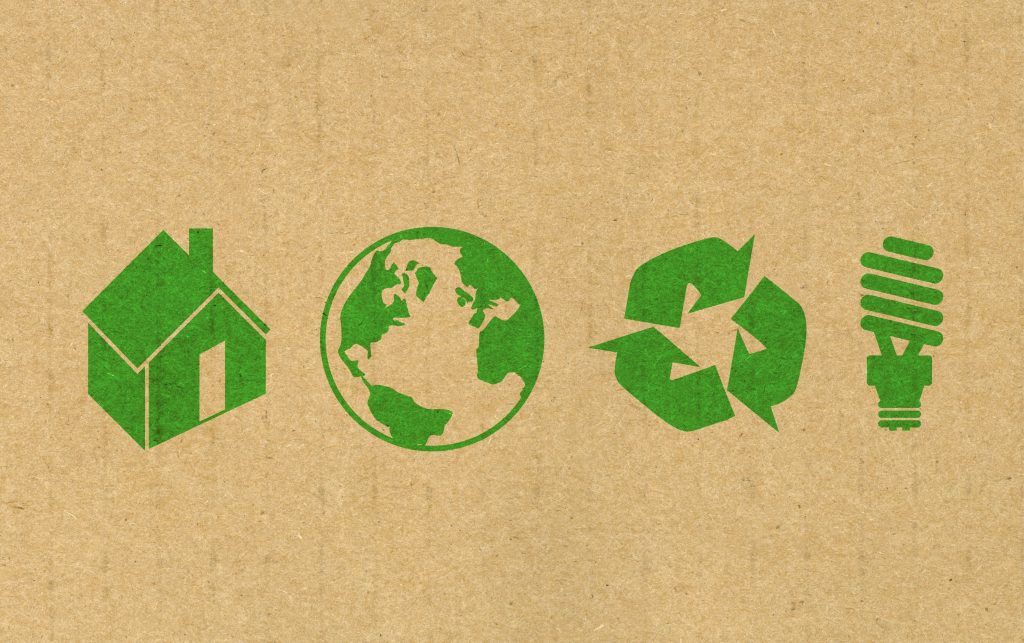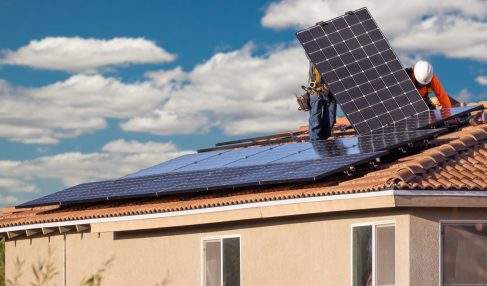Being eco-friendly means living in a way that is not harmful to the environment. This way of life is becoming increasingly important, as we need to protect earth from man-made damage. Here are 20 small changes to make at home that can make a big impact on the environment:
1. Switch to LED Light Bulbs

Lighting accounts for about 9 percent of a typical home’s energy use. An easy way to reduce your energy bill and your environmental footprint is to replace all your light bulbs with LED bulbs. LEDs (especially ENERGY STAR rated products) use at least 75% less energy, and last 25 times longer than incandescent lighting. Another added benefit of LED bulbs is the amount of heat they emit. LED lights emit less heat, which directly and indirectly can save even more energy.
2. Stop Buying Bottled Water
Single-use plastic water bottles are incredibly wasteful and have a very negative impact on the environment. An estimated 80 percent of water bottles don’t get recycled and, because of the plastic production process, it takes three times the amount of water in a water bottle to produce just one. A solution to this problem is to invest in a water bottle that is not only reusable but also the right size, so you can take it with you wherever you go.
3. Start Recycling and Composting
Be more conscious about recycling glass bottles, jars, paper, and other items that should be recycled. To make recycling and composting as easy as possible, make sure to have bins for trash and recycling in more rooms than just the kitchen.
A compost bin will help you get rid of leftovers and will give you free fertilizer you can use for your plants. Many compost bins are designed to be neat, tidy, and odor-free.
4. Use Organic Cleaning Products
Household cleaning supplies are filled with the most powerful bacteria killers. Unfortunately, these cleaners aren’t good for the environment, and many have toxic effects on animal and plant life once they enter our waterways via sewer systems.
Organic cleaning products use environmentally-friendly ingredients that reduce toxicity. Or an alternative is you can make your own cleaning products using items like vinegar, baking soda, and lemon juice. Additionally, making your own products cuts down on packaging waste and reduces the release of household chemicals.
5. Use Less Paper Towels
You don’t have to give up paper towels completely, but it’s best to use them sparingly. Instead of purchasing a dozen rolls of paper towels when you are ready to do your spring cleaning, cut up an old t-shirt and use that as a rag instead.
6. Use Eco-Friendly Toilet Paper
A lot of trees are cut down in order to make toilet paper rolls. It requires at least 17 trees and 90,921 liters of water for a ton of toilet paper rolls. Consumers can use eco-friendly toilet paper made out of bamboo. Bamboo grows incredibly fast, with some species growing as much as 36 inches in a 24 hour period. Toilet paper made out of bamboo is a much more sustainable option compared to regular toilet paper.
7. Install a Smart Thermostat
A smart thermostat can reduce the cost of your utility bill and make your home more eco-friendly at the same time. For many people, the biggest reason to upgrade to a smart thermostat is for the energy cost savings. With a smart thermostat, it’s easy to schedule your HVAC to run less while you’re out for the day, so you’ll use less energy by cooling your home only while you’re home.
8. Turn Off Lights
There’s a reason light switches are located by the door! Make a habit of turning them off when leaving a room, and especially whenever you leave the house—you’ll save energy (and save on the energy bill) in the process.
9. Wash Your Clothes in Cold Water
Up to 90% of the energy a washing machine uses goes toward heating water, according to Energy Star. By using the cold water setting on your washing machine, you can eliminate up to 1,600 pounds of carbon dioxide emissions per year.
Unless you’re dealing with stubborn stains like oil stains, there really isn’t a point in running your washing machine on the hot water setting. If you feel the cold water setting doesn’t do a proper job, you can try the warm setting. Energy-wise it’s still better than using the hot water one, but also more efficient for cleaning than the cold water setting.
10. Dry Laundry on a Clothesline
The EPA determined that a dryer uses more energy than a refrigerator, washer, and dishwasher, and line drying can reduce energy usage from major appliances in a typical household by as much as one-third. During our hot, sunny months, it’s almost a shame to not line-dry your clothes outside.
11. Install a Low-Flow Toilet
According to the EPA, toilets account for almost 30 percent of the average household’s indoor water usage. One easy way to slash this number is by upgrading an older toilet model to an EPA-certified WaterSense model. Older toilets use as much as six gallons per flush, while newer, more efficient toilets use about one gallon or less.
12. Install Low-Flow Shower Head
The investment in a low-flow shower head will be worth it when you receive your next water bill and it is significantly lower than the last. Older shower heads release approximately five gallons of water a minute, which adds up quickly, especially if you have multiple people showering in the house. Low-flow shower heads, such as those with the WaterSense label, use less than two gallons per minute, conserving more water and cutting down your water bill.
13. Take Shorter Showers
Shortening your shower by a minute or two can save up to 150 gallons of water per month.
14. Fix Leaking Toilets and Faucets
Leaking toilets and faucets may not seem like a big deal, but they can waste a lot of water. According to EPA.gov, 10 percent of homes have leaks that can waste up to 90 gallons or more of water per day, and the average household’s leaks can account for more than 10,000 gallons of water wasted every year. Listen for any dripping noises you might hear around the house. If you notice a leak, you’ll need to call a plumber to assess the situation. If left untreated, the fixture may need to be replaced or your pipes may need to be fixed.
It’s especially important to stay vigilant if you plan to sell your home, plumbing is part of every standard home inspection. If there are leaks, it may signal to potential buyers that you haven’t been maintaining the home.
15. Seal Gaps Around Doors and Windows
Older homes tend to have gaps around doors and windows that let outside air in or inside air escape. If your home has gaps, the air coming from your AC will literally be going out the window. Installing weather stripping around doors and windows will save you money on your heating and cooling bill, and will make your home more energy-efficient.
16. Buy Energy-Efficient Appliances
If you need to replace any household appliances like dishwashers, washing machines, dryers, ovens, and refrigerators, look for Energy Star labels. Energy Star is a partnership between the EPA and appliance manufacturers. The label shows consumers that a third-party has verified that the product is low water and low energy. Energy Star Appliances, may cost a bit more money to buy initially, but are more durable, more environmentally friendly, and will save cash on utility bills.
17. Install Artificial Grass
Environmentally conscious homeowners have begun transitioning to artificial grass in recent years to reduce water use in the desert. Contrary to common artificial grass myths & misconceptions, manufactured grass is actually good for the environment.
“According to the U.S. Environmental Protection Agency (EPA), over one-third of residential water is used for lawn irrigation nationwide, totaling more than 4 billion gallons of water a day. The Southern Nevada Water Authority also estimates that every square foot of grass replaced with synthetic turf saves an additional 55 gallons of water per year. Therefore, an average lawn of 1,800 square feet will save 99,000 gallons of water a year if landscaped with synthetic turf – about 70% of a homeowner’s water bill, or up to $500.”
Turf products installed by a reputable artificial grass company can last upwards of 20-25 years, meaning homeowners will likely see a return on their investment within 2-7 years. One of the biggest financial and environmental savings that fake grass creates is in water. The average American family uses 320 gallons of water per day, about 30 percent of which is devoted to outdoor uses.
18. Eat Less Meat
Believe it or not, reducing how much meat you eat can make a huge difference in the environment. More than 30 percent of the Earth’s surface is being used to raise and support livestock. According to a United Nations study, “the livestock sector accounts for 9 percent of CO2 deriving from human-related activities, but produces a much larger share of even more harmful greenhouse gases. It generates 65 percent of human-related nitrous oxide, which has 296 times the Global Warming Potential (GWP) of CO2.” Cutting back on your meat consumption is an important step in reducing the overall emission of GWP gases.
19. Use Reusable Grocery Bags
Most stores offer a canvas bag alternative to their wasteful generic plastic and paper bags. Even if you don’t use canvas bags, reusing plastic bags is a great way to live more eco-friendly. Just use your plastic bags in small garbage cans throughout your home, or recycle your used grocery bag!
20. Go Paperless
Switching to paperless billing lowers the odds of losing bills in the mail and getting the electricity cut off right before your movie marathon. Plus, many billers offer a discount for going paperless because it saves them money on stamps and printing. If you do use paper, remember to recycle. More than 40 percent of municipal solid waste is paper and paper products.




